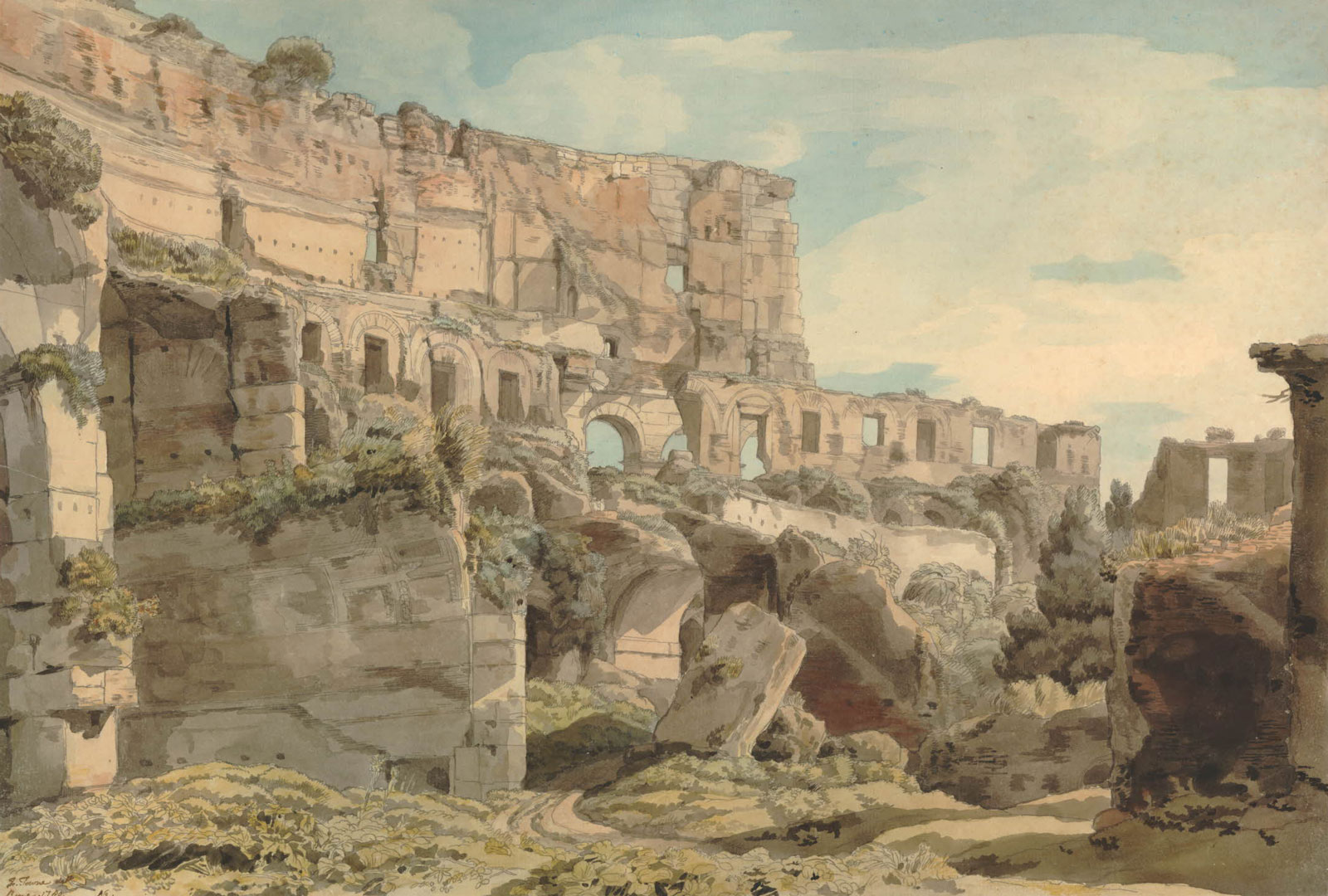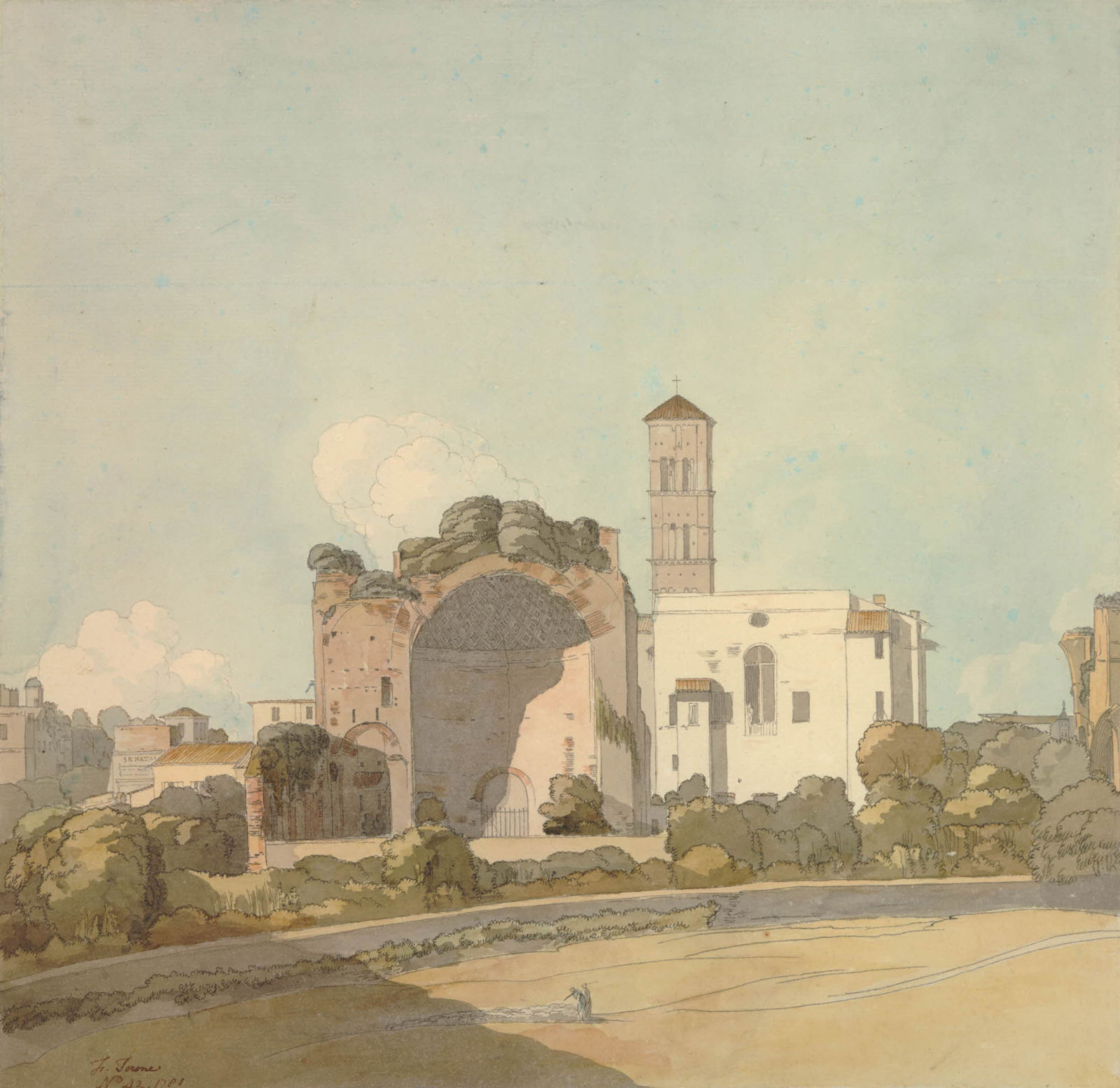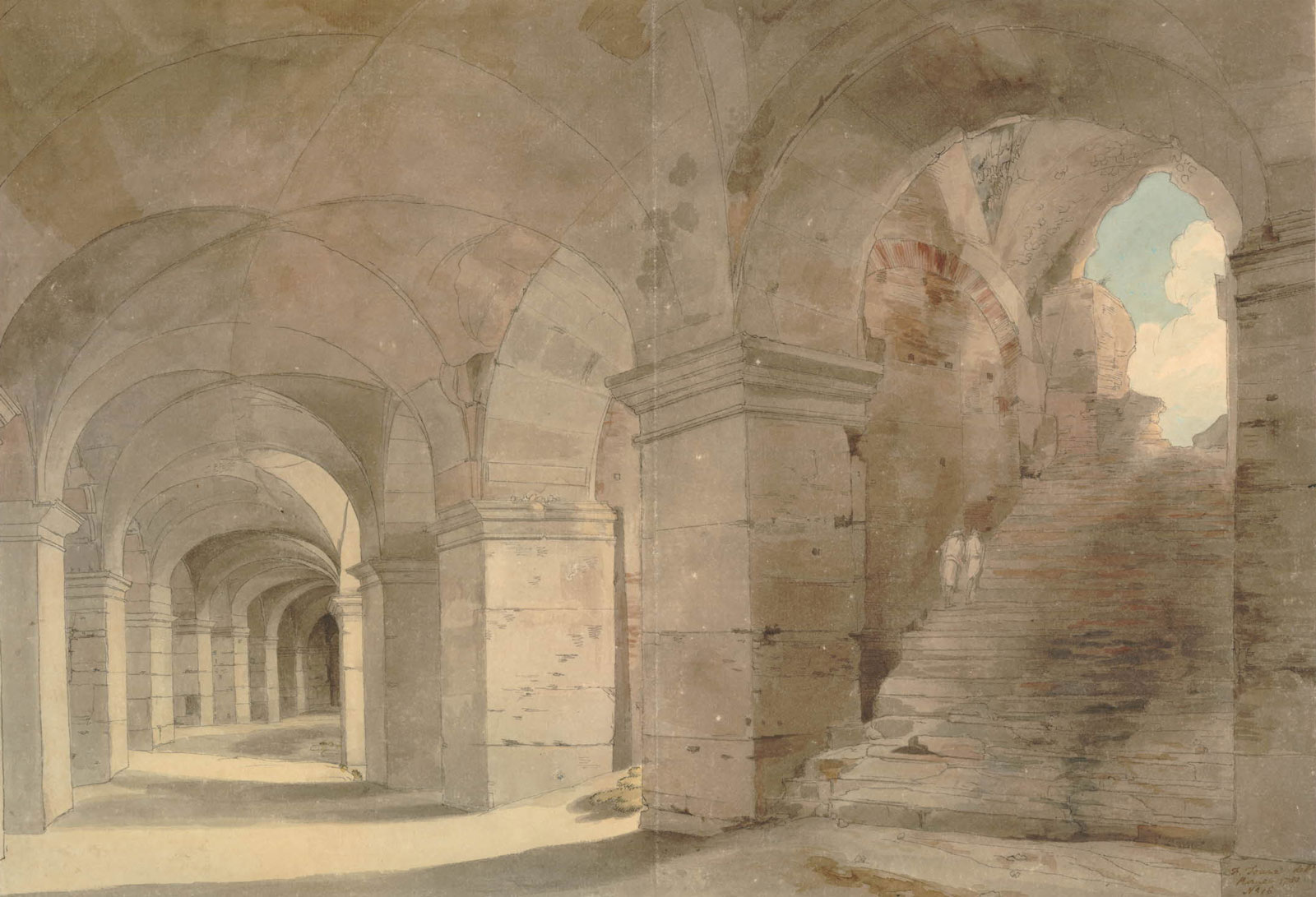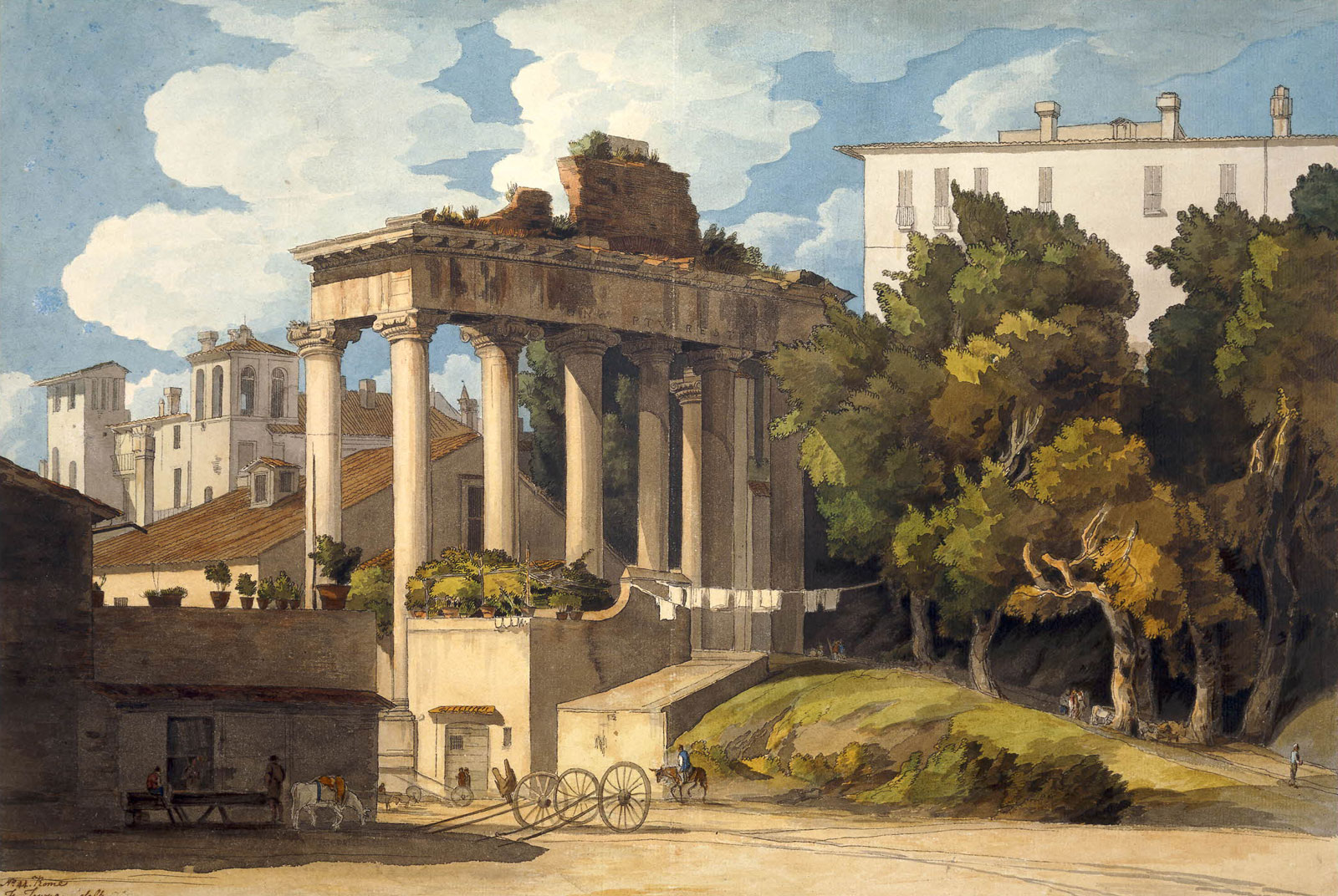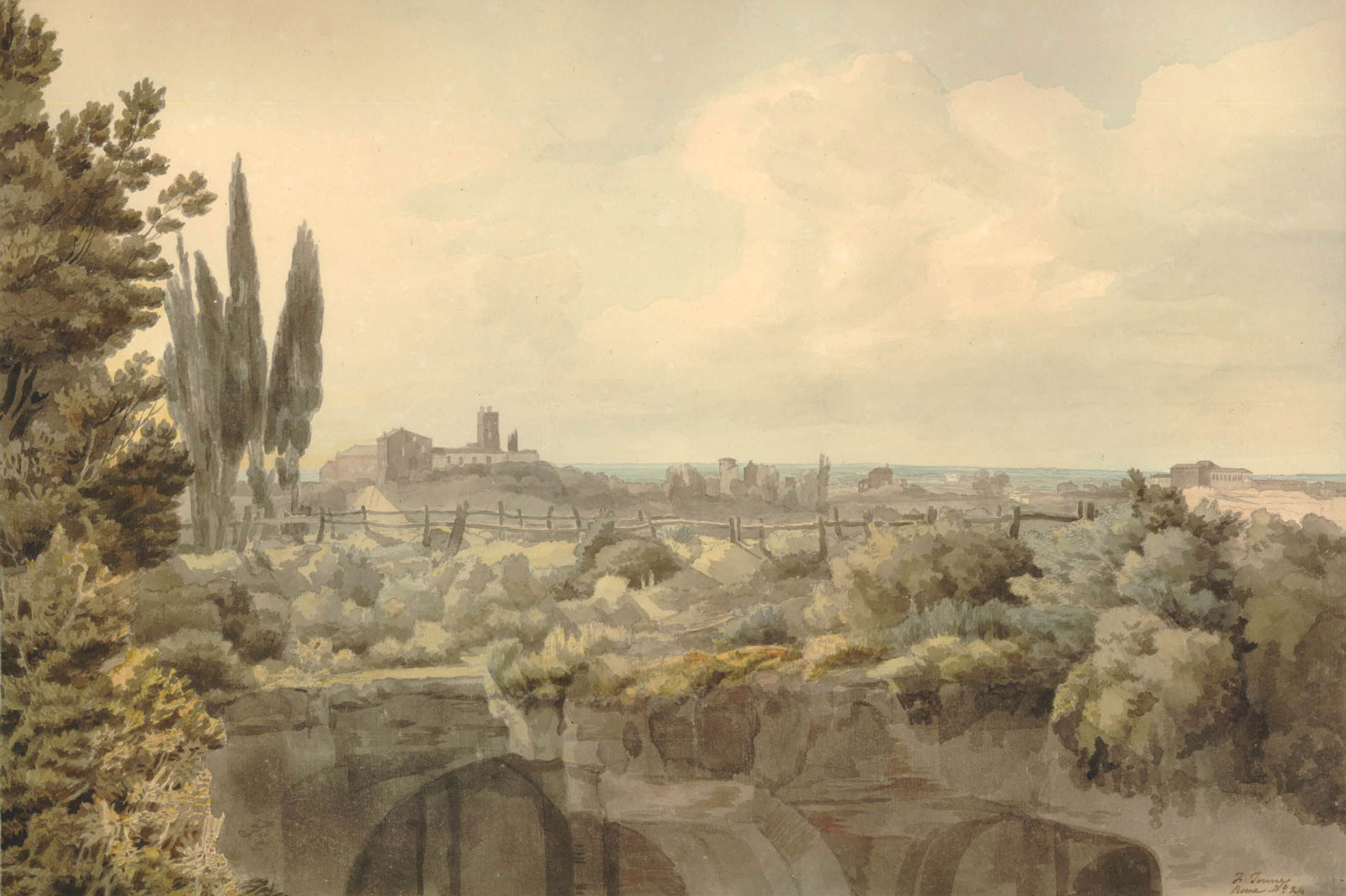You can feel the heat in the pale blue sky, a burning day in high summer. The year is 1781, and Francis Towne is painting in the shade, looking across a swathe of burnt grass to the church of Santa Maria Nova. The church rubs shoulders with the ruined, foliage-covered arch of a Roman temple and the conjunctions of curve and square, classical and Renaissance, are almost diagrammatic—indeed for the glaring white walls of the church, Towne has simply left a square of white paper. Triangles of shadow emphasize the contrasts, softened by clumpy trees, with the central pointing finger of the campanile cut between the picture’s planes, a trick Towne often used. So elegant is the pale geometry of this watercolor, that it reminds one of—or anticipates—the modernist painters of the 1930s. This is a man both in, and out of, his time.
Towne (1739-1816), who spent most of his career in Exeter, with visits to his native London, has always been one of my favorite eighteenth-century watercolorists, for his flowing outlines and luminous skies. I particularly love his paintings of the English Lake District, which I know well: while other artists drew unrecognizable crinkly crags and fussy foliage, Towne caught the curve of the fells and the gleam of the water in a way that set him apart. For years he was ignored, but although critics and art-historians now recognize his talent, many people still don’t know his name. So it’s exciting to see viewers bowled over by the current exhibition of his paintings from Rome, selected from the amazing archive of the Department of Prints and Drawings at the British Museum to celebrate the two hundredth anniversary of his death, and curated by Richard Stephens (who has just compiled a catalogue raisonné of Towne’s work, to be published online this spring by the Paul Mellon Centre).
It’s a fascinating show, not only because we can see Towne’s skill, and his oblique, personal vision of the Eternal City, but also because it illustrates the long tradition of British artists working in Rome, faithfully following set conventions, almost plonking down their easels in the marks left by the artists before them. Towne does this too, but he also finds hidden lanes and byways, and in the process also finds a new style—a landmark in the history of watercolors.
Towne was forty-one, no stripling, when he arrived in Italy in October 1780. Born a Londoner, he had begun his career as a coach-painter, moving in his twenties to Exeter. There, he became a respected drawing master and painter of West Country landscapes, of scenes of the lakes and of North Wales. His work was admired, yet the London art establishment dismissed him as a provincial drawing teacher—while he, on the other hand, was equally disdainful in return, adopting the habit of his Exeter patrons of praising rural retirement and virtue in contrast to the vanities of city life, and defending British liberties against an oppressive, self-interested Westminster rule. A serious, thoughtful man, he carried this thinking to Italy—Rome, so vivid in its ruins, was a lesson, he felt, for the corrupt contemporary world, its message linked to the call to protect traditional British liberties and freedoms from an over-powerful Westminster government.
Towne’s paintings suggest a wariness about approaching the great city. He began with views from without, pacing the countryside that his hero Claude Lorrain had known: the bare wastes of the Campagna; country walks by the river near the Ponte Molle, on the road from the north; deep lanes overshadowed by trees with a glimpse of the Villa Borghese, almost like a Devon mansion, on a nearby hill. Towne preferred the back of things, the uncommon view, high walls, old Roman gates, suggesting a life beyond. He ignored modern Rome; he gives no hint of grand Papal processions, of high-life, of the color and glamor that wowed the young men on their Grand Tours.
He did, of course, paint the great ruins, walking through the bustling streets from the artists quarter near the Piazza di Spagna, across the city to the Forum and the Colosseum, working there side by side with his friend John “Warwick” Smith. His paintings mixed topographical accuracy—long curves of arches and sharp lines of formal columns—with a lyrical, romantic disarray. Nature, it seems, can invade and outlast human grandeur. Tangled creepers hang through the broken vaults of the Colosseum, olive trees and cypresses rise from the dusky shadows of the Baths of Caracalla. The effect is monumental yet subtle, showing Towne studying the effects of light at different times, working fast, in the open, making shadows and shafts of light part of his vision.
Advertisement
In these crumbling spaces few figures appear. When they do, they seem disproportionately small, dwarfed by their surroundings. And they are not grand folk but peasants, herding cattle, or riding by on a mule. By the mighty, golden columns of a temple, an old horse taken out of its shafts waits patiently in the shade.
Towne dutifully followed the artists’ itinerary defined by the landscape painter Richard Wilson in the 1750s. This took him outside Rome, to Tivoli, with its ravines and waterfalls and grottoes, a place hallowed by the atmospheric paintings of Lorrain and Nicolas Poussin. He went inland to the Alban Hills, painting the views from Frascati over ripples of blue hills, sketching Lake Nemi in its crater, with the line of the sea in the distance cutting his page in half. Yet although these were familiar subjects, everywhere Towne went he produced unusual, sideways versions of set views. When he visited the Welsh artist Thomas Jones in Naples, he turned his back on the accepted glories and sought out the back ways: in one view down a narrow lane, squeezed between tower and trees, the grand Bay of Naples is reduced to a shimmer, gleaming in the background.
As he worked, Towne grew more independent, more adventurous. He abandoned his small sheets for larger ones, using a new, thickly woven Italian paper that made it easier to apply his color washes, and produced more glowing effects. Sometimes he extended the scene by adding separate sheets at the side, or below. He still sketched in pencil in the conventional manner, “penning-out”—tracing the outline in pen—back at his lodgings. But he began to abandon this too, sometimes omitting pen altogether, sometimes scratching it out afterward, seeking freedom, adopting new ways.
Toward the end of his stay, Towne produced spare, almost emblematic masterpieces, paintings of ruins and buildings that seem to float in the light. Back in England he sold copies to his West Country patrons, and he revised the originals often over the years, adjusting to changing tastes as the years rolled on into the age of Thomas Girtin and J.M.W. Turner, adding new layers of color and extra features like trees or foreground foliage, and setting them on stiff mounts with fresh inscriptions. He knew that his work in Rome was important: on his death he left fifty-four watercolors from his Italian stay to the British Museum. But by then he seemed an odd, idiosyncratic artist from an earlier age, and his portfolio lingered unopened until a pioneering study by Paul Oppé in the early twentieth century roused attention again.
Now Towne’s haunting paintings are back in the light, beautifully displayed—they may appear a mere sideshow in comparison to the blockbuster exhibitions of great names, but they offer a luminous vision of a civilization lost in time, a tribute to the genius of a quiet man.
“Light, Time, Legacy: Francis Towne’s Watercolors of Rome” is on view at the British Museum through August 14.

